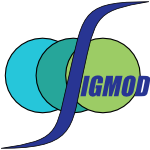11 papers:
 SEKE-2015-Tasse #analysis #identification #metric #using
SEKE-2015-Tasse #analysis #identification #metric #using- Using peak analysis for identifying lagged effects between software metrics (JT), pp. 512–515.
 CSCW-2013-YamashitaEIH #collaboration #how #multi
CSCW-2013-YamashitaEIH #collaboration #how #multi- Lost in transmittance: how transmission lag enhances and deteriorates multilingual collaboration (NY, AE, TI, AMJH), pp. 923–934.
 KDD-2012-TangLS #dependence
KDD-2012-TangLS #dependence- Discovering lag intervals for temporal dependencies (LT, TL, LS), pp. 633–641.
 CASE-2011-ZanasiC #design #visual notation
CASE-2011-ZanasiC #design #visual notation- Direct method for digital lead-lag design: analytical and graphical solutions (RZ, SC), pp. 804–809.
 CSCW-2008-StuckelG #distributed #interactive
CSCW-2008-StuckelG #distributed #interactive- The effects of local lag on tightly-coupled interaction in distributed groupware (DS, CG), pp. 447–456.
 ICML-2008-HyvarinenSH #modelling
ICML-2008-HyvarinenSH #modelling- Causal modelling combining instantaneous and lagged effects: an identifiable model based on non-Gaussianity (AH, SS, POH), pp. 424–431.
 SIGMOD-2005-SakuraiPF #correlation #mining #named
SIGMOD-2005-SakuraiPF #correlation #mining #named- BRAID: Stream Mining through Group Lag Correlations (YS, SP, CF), pp. 599–610.
 KDD-2002-LiangK #mining #network
KDD-2002-LiangK #mining #network- Mining heterogeneous gene expression data with time lagged recurrent neural networks (YL, AK), pp. 415–421.
 HCI-SEC-1997-So #bibliography #image #industrial #predict
HCI-SEC-1997-So #bibliography #image #industrial #predict- Lag Compensation by Image Deflection and Prediction: A Review on the Potential Benefits to Virtual Training Applications for Manufacturing Industry (RHYS), pp. 997–1000.
 ICFP-1996-RojemoR #compilation #profiling #revisited
ICFP-1996-RojemoR #compilation #profiling #revisited- Lag, Drag, Void and Use — Heap Profiling and Space-Efficient Compilation Revisited (NR, CR), pp. 34–41.
 INTERCHI-1993-MacKenzieW #interactive #performance
INTERCHI-1993-MacKenzieW #interactive #performance- Lag as a determinant of human performance in interactive systems (ISM, CW), pp. 488–493.
 SEKE-2015-Tasse #analysis #identification #metric #using
SEKE-2015-Tasse #analysis #identification #metric #using CSCW-2013-YamashitaEIH #collaboration #how #multi
CSCW-2013-YamashitaEIH #collaboration #how #multi KDD-2012-TangLS #dependence
KDD-2012-TangLS #dependence CASE-2011-ZanasiC #design #visual notation
CASE-2011-ZanasiC #design #visual notation CSCW-2008-StuckelG #distributed #interactive
CSCW-2008-StuckelG #distributed #interactive ICML-2008-HyvarinenSH #modelling
ICML-2008-HyvarinenSH #modelling SIGMOD-2005-SakuraiPF #correlation #mining #named
SIGMOD-2005-SakuraiPF #correlation #mining #named KDD-2002-LiangK #mining #network
KDD-2002-LiangK #mining #network HCI-SEC-1997-So #bibliography #image #industrial #predict
HCI-SEC-1997-So #bibliography #image #industrial #predict ICFP-1996-RojemoR #compilation #profiling #revisited
ICFP-1996-RojemoR #compilation #profiling #revisited INTERCHI-1993-MacKenzieW #interactive #performance
INTERCHI-1993-MacKenzieW #interactive #performance









